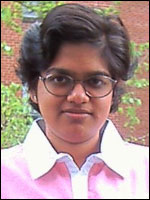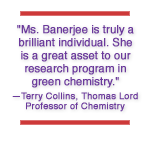|
|
|||||
|
|
Carnegie Mellon Graduate Student Named Prestigious Teresa Heinz Scholar for Advancing Field of Green Chemistry
Funded by the Teresa and H. John Heinz III Foundation, these annual awards provide exemplary graduate students from nine institutions around the country with financial support to enhance their research, which is aimed at providing effective solutions for environmental problems and enriching public understanding of emerging environmental issues. Banerjee is one of only eight doctoral students to receive this award this year.
"Ms. Banerjee is truly a brilliant individual," said Terry Collins, the Thomas Lord Professor of Chemistry and director of the Institute for Green Oxidation Chemistry at the Mellon College of Science. "She is a great asset to our research program in green chemistry."
At the institute, Banerjee has joined a 25-year-old research effort to design, synthesize and optimize the use of Iron-Tetra-Amido Macrocyclic Ligand (Fe-TAML®) activators. In the presence of oxygen or hydrogen peroxide, Fe-TAML activators catalyze reactions in which environmental contaminants are disabled, rendered less toxic or destroyed.
Banerjee has developed Fe-TAMLs to kill spores of a cultured, benign anthrax simulant. The Fe-TAMLs have been so successful in this setting that they should also destroy the lethal anthrax spores. The catalysts, or modified versions of them, also may eventually be used to destroy other microbial pathogens that, like anthrax, are toxic, hard to destroy and responsible for diseases that compromise the health of human communities around the world.
Banerjee will use award funding to conduct research to find a nontoxic organic solvent that helps Fe- TAMLs kill bacterial spores for special circumstances such as the rapid decontamination of a building. Water, the solvent typically used in Fe-TAML-peroxide systems, is not ideal for some cases of anthrax decontamination. Banerjee also will optimize the Fe-TAML-peroxide system to destroy a range of other potentially deadly microorganisms in a variety of environments. In addition, she will contribute to wider efforts to design Fe-TAML-peroxide systems capable of degrading water-insoluble, persistent organic pollutants, including many pesticides, commercial dyes and chemical warfare agents.
Before coming to Carnegie Mellon in 2002, Banerjee graduated in 2001 as valedictorian of her master's class in chemistry at the Indian Institute of Technology (IIT) in Kanpur, one of India's top science and technology institutes. In 1999, she earned her bachelor of science in chemistry, with honors, from Presidency College, University of Calcutta, where she was class valedictorian.
To be eligible for a Teresa Heinz Scholars for Environmental Research award, students must be in doctor's or master's programs at Carnegie Mellon, Cornell, Harvard, Penn State, Princeton, Stanford or Yale or in master's programs at Florida A&M or Texas A&M at Corpus Christi. Each year, only eight doctoral and eight master's students win these prestigious awards.
Kate R. Hough |
|||
|
Carnegie Mellon Home |
|||||

 Fe-TAML activators hold tremendous promise for making many industrial processes greener and detoxifying resources contaminated by less environmentally friendly processes.
Fe-TAML activators hold tremendous promise for making many industrial processes greener and detoxifying resources contaminated by less environmentally friendly processes.